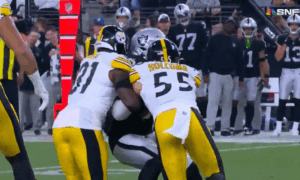As we have found out over time in the National Football League, the running back position can be fairly fungible as our own Dave Bryan has often stated. Obviously you have your superstar running backs like Christian McCaffrey that are hard to replace, but most other top backs in the league can get subbed out for a lesser-known back and the offense will see only a slight dip in production…if any.
Take the Pittsburgh Steelers, for example. They spent a first-round pick on RB Najee Harris, who played well as a rookie in 2021, being the team’s workhorse back. However, the team started to incorporate Jaylen Warren more into the offense last year, the undrafted free agent providing elements of speed and burst that Harris couldn’t provide and ultimately making the backfield a 50/50 split this season as Pittsburgh’s most talented runner.
The running back position has long been known as the league’s most fungible position, but what position comes after it? Well, if we were to look at the defensive side of the football, one would argue that inside linebacker would be a position where the value upon replacement can similarly match that of the running back position in the NFL.
This isn’t to say that you don’t have impact playmakers at off-ball linebacker who are almost impossible to replace should they go down to injury. Guys like Fred Warner and Roquan Smith are stud defenders who excel in pursuit of the ball carrier as run defenders, rushing the quarterback as blitzers, and operating well in space as coverage defenders. They are true three-down linebackers who can do it all. After those top guys, the quality of play drops off with plenty of players having their specific niche or role but not the full skill set to the level of those guys at the top.
Look at the Steelers. They signed Cole Holcomb to a respectable deal (three years, $18 million) to be their three-down linebacker. Sure, he may have more of a well-rounded skill set than the rest, but Pittsburgh was able to sign him to a deal with an average yearly value of $6 million rather than paying nearly $20 million for one of the top guys. Behind Holcomb were LBs Kwon Alexander, who also has a three-down skill set, and Elandon Roberts. who is more of a two-down run stopper. Roberts saw his role increase out of necessity with Alexander and Holcomb out for the season, forcing him into a full-time role that he has managed to play well in the last few weeks.
However, we saw Pittsburgh add potential reinforcements to its beat-up inside linebacker room this week, signing LBs Myles Jack and Blake Martinez to help fill the void left by the veterans placed on the IR. Jack and Martinez may not be as fresh as what Holcomb and Alexander were, but both are seasoned vets who have ample starting experience in the league. Each likely on the fast track to playing time to beside Roberts and possibly in front of guys like Mykal Walker and Mark Robinson, who have less experience.
We used to make a big deal about Pittsburgh signing a guy like Jack in the offseason or executing a trade to get Joe Schobert prior to the start of the season to help bolster the linebacker corps. However, we’ve now seen Pittsburgh add five such guys since the season started. That suggests that acquiring an experienced linebacker could be very much like the running back position, almost being a dime-a-dozen approach when it comes to loading up on experienced veterans who can create a capable rotation.
We’ve seen the same with other teams this season. The Cowboys signed LB Rashaan Evans to help fill the void after injuries to their inside linebackers, adding a 28-year-old veteran who made 159 total tackles with the Falcons last year halfway through the season. The Vikings did the same thing last week, signing long-time starter Anthony Barr back while they dealt with injuries to their starting inside linebackers.
This isn’t to say that Jack and Martinez can step right in and provide the exact same level of play that Holcomb and Alexander did. Rather, the thought by Pittsburgh is to acquire as many proven veterans as possible to plug in and experience as little drop off, if any, while attempting to keep the ship afloat. The team failed to incorporate this recipe when Ryan Shazier went down, opting to sign Sean Spence off the couch rather than go get a guy who could better fill the void as a capable starter. Pittsburgh isn’t making that mistake again after having the room ravaged with injuries, opting to add as much experience as possible to see what sticks.








